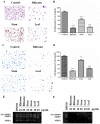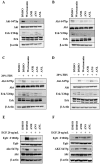Ethanol Extracts of Dietary Herb, Alpinia nantoensis, Exhibit Anticancer Potential in Human Breast Cancer Cells
- PMID: 31409145
- PMCID: PMC6696839
- DOI: 10.1177/1534735419866924
Ethanol Extracts of Dietary Herb, Alpinia nantoensis, Exhibit Anticancer Potential in Human Breast Cancer Cells
Abstract
Recent advances in mammography screening, chemotherapy, and adjuvant treatment modalities have improved the survival rate of women with breast cancer. Nevertheless, the breast tumor with metastatic progression is still life-threatening. Indeed, combination therapy with Ras-ERK and PI3K inhibitors is clinically effective in malignant breast cancer treatment. Constituents from genus Alpinia plants have been implicated as potent anticancer agents in terms of their efficacy of inhibiting tumor cell metastasis. In this study, we tested the effects of ethanol extracts of Alpinia nantoensis (rhizome, stem, and leaf extracts) in cultured human breast cancer cells and particularly focused on the Ras-ERK and PI3K/AKT pathways. We found that the rhizome and leaf extracts from A nantoensis inhibited cell migration, invasion, and sphere formation in MCF-7 and MDA-MB-231 cells. The potency was extended with the inhibition of serum-induced PI3K/AKT and Ras-ERK activation and epidermal growth factor (EGF)-mediated EGFR activation in MDA-MB-231 cells. These results indicate that extracts of A nantoensis could inhibit signal transduction at least involved in EGFR as well as the PI3K/AKT and Ras-ERK pathways, which are crucial players of tumor cell migration and invasion. Our study strongly supports that the extracts of A nantoensis could be a novel botanical drug lead for the development of an antimetastatic agent for the treatment of human malignant breast cancer.
Keywords: EGFR; PI3K/AKT; Ras-ERK; breast cancer; metastasis.
Conflict of interest statement
Figures





Similar articles
-
Opposite regulation by PI3K/Akt and MAPK/ERK pathways of tissue factor expression, cell-associated procoagulant activity and invasiveness in MDA-MB-231 cells.J Hematol Oncol. 2012 Jul 11;5:16. doi: 10.1186/1756-8722-5-16. J Hematol Oncol. 2012. PMID: 22534171 Free PMC article.
-
Inhibition of EGF/EGFR activation with naphtho[1,2-b]furan-4,5-dione blocks migration and invasion of MDA-MB-231 cells.Toxicol In Vitro. 2013 Feb;27(1):1-10. doi: 10.1016/j.tiv.2012.10.001. Epub 2012 Oct 12. Toxicol In Vitro. 2013. PMID: 23064031
-
(-)-Liriopein B Suppresses Breast Cancer Progression via Inhibition of Multiple Kinases.Chem Res Toxicol. 2015 May 18;28(5):897-906. doi: 10.1021/tx500518j. Epub 2015 Apr 21. Chem Res Toxicol. 2015. PMID: 25856345
-
Promising Anticancer Activities of Alismatis rhizome and Its Triterpenes via p38 and PI3K/Akt/mTOR Signaling Pathways.Nutrients. 2021 Jul 18;13(7):2455. doi: 10.3390/nu13072455. Nutrients. 2021. PMID: 34371964 Free PMC article. Review.
-
PI3K/Akt/mTOR and Ras/Raf/MEK/ERK signaling pathways inhibitors as anticancer agents: Structural and pharmacological perspectives.Eur J Med Chem. 2016 Feb 15;109:314-41. doi: 10.1016/j.ejmech.2016.01.012. Epub 2016 Jan 12. Eur J Med Chem. 2016. PMID: 26807863 Review.
Cited by
-
Multiplicative Effects of Essential Oils and Other Active Components on Skin Tissue and Skin Cancers.Int J Mol Sci. 2024 May 15;25(10):5397. doi: 10.3390/ijms25105397. Int J Mol Sci. 2024. PMID: 38791435 Free PMC article. Review.
-
Essential Oils of Alpinia nantoensis Retard Forskolin-Induced Melanogenesis via ERK1/2-Mediated Proteasomal Degradation of MITF.Plants (Basel). 2020 Nov 28;9(12):1672. doi: 10.3390/plants9121672. Plants (Basel). 2020. PMID: 33260669 Free PMC article.
-
The polyphenol/saponin-rich Rhus tripartita extract has an apoptotic effect on THP-1 cells through the PI3K/AKT/mTOR signaling pathway.BMC Complement Med Ther. 2021 May 27;21(1):153. doi: 10.1186/s12906-021-03328-9. BMC Complement Med Ther. 2021. PMID: 34044827 Free PMC article.
-
Ethnobotanical survey of medicinal plants used in management of breast cancers in Qatar.Heliyon. 2025 Feb 7;11(4):e42541. doi: 10.1016/j.heliyon.2025.e42541. eCollection 2025 Feb 28. Heliyon. 2025. PMID: 40028611 Free PMC article.
References
-
- Siegel RL, Miller KD, Jemal A. Cancer statistics, 2016. CA Cancer J Clin. 2016;66:7-30. - PubMed
-
- Lim E, Metzger-Filho O, Winer EP. The natural history of hormone receptor-positive breast cancer. Oncology (Williston Park). 2012;26:688-694, 696. - PubMed
-
- Liu CY, Wu CY, Petrossian K, Huang TT, Tseng LM, Chen S. Treatment for the endocrine resistant breast cancer: current options and future perspectives. J Steroid Biochem Mol Biol. 2017;172:166-175. - PubMed
Publication types
MeSH terms
Substances
LinkOut - more resources
Full Text Sources
Medical
Research Materials
Miscellaneous

